Building One Livable City
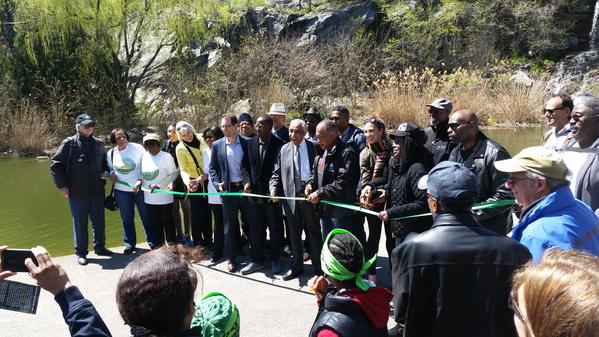
A NYC park ribbon-cutting (@MarkLevineNYC)
New York is embarking on a building boom, and upzoning neighborhoods around the boroughs, with the laudable goal of making the city more affordable. But will it be more livable?
The answer depends, in part, on whether we plan for green space and open space to match all the new construction. With residential towers set to rise in at least 15 neighborhoods in line for new zoning, and the pace of building picking up city-wide, it's critical that we account for the infrastructure of public life. This means investing in new parks, playgrounds, street trees, and "green" features like bioswales as our city expands.
Fix NYCHA First

NYCHA buildings in Harlem (photo: David Schalliol)
Mayor Bill de Blasio and his administration have turned heads with bold plans for lifting 800,000 families out of poverty, boosting school performance, and making the city more livable and equitable for all. His OneNYC plan aims to do nothing less than convert New York City into a progressive Sweden on the Hudson. The affordable housing component of the plan, the outline of which was first announced last year, alone promises to help finance construction of 80,000 units of below-market subsidized housing, extend subsidies for 120,000 existing units, and stimulate construction of 160,000 market-rate apartments, in part to relieve overall pressure on prices.
Let's Note the Mayor's Budget Investment in an Instrumental Workforce
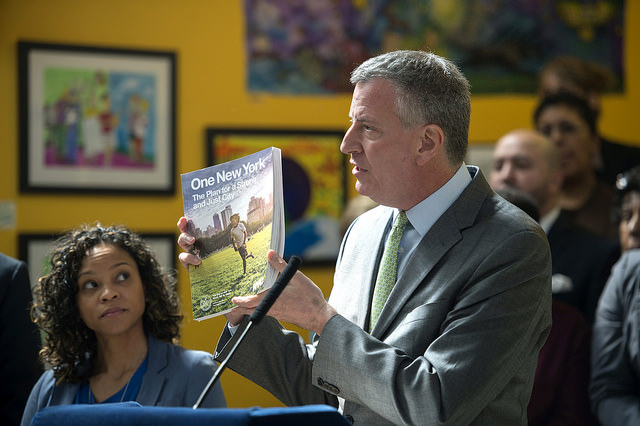
Mayor de Blasio (photo: Demetrius Freeman/Mayoral Photography Office)
Mayor Bill de Blasio recently unveiled his Executive Budget for Fiscal Year 2016. Since then, there has been much comment on what the budget includes, notably $100 million for homelessness, and omits, namely funding to hire 1,000 NYPD officers. Nearly absent in budget conversation, though, is the important investment that the city is making in the human service nonprofit sector in the form of a 2.5 percent Cost of Living Adjustment (COLA) and an unprecedented $11.50 per hour wage floor.
Read more: Let's Note the Mayor's Budget Investment in an Instrumental Workforce
Restorative Justice is Key to School Discipline Reform

A discussion on school discipline (photo: @Teachers_Unite)
Since the founding of Bronx Lab School in 2004, "student discipline" has been an ongoing topic of discussion. Students, staff, and parents are continually debating the merits and efficacy of suspensions, detentions, and mediations in addressing the realities of student conflict and non-adherence to school policies and values. What we know for sure after more than a decade of these conversations is that there are no simple answers. What we have learned is, though, is that Restorative Justice supports our community's mission and values, and offers a humanizing approach to the ever-present "discipline" question.
Read more: Restorative Justice is Key to School Discipline Reform
Time to Reduce New York City's Stubborn Child Poverty Rate
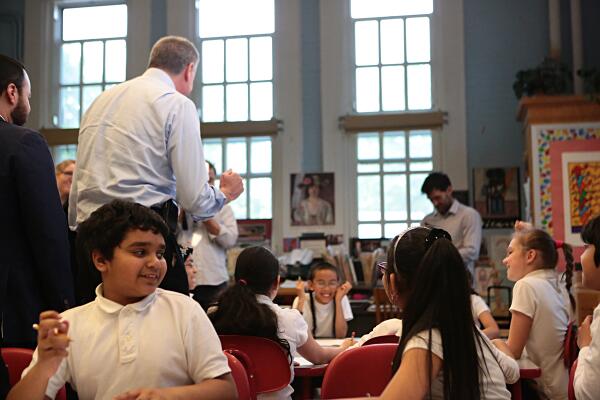
Mayor de Blasio visits a classroom (photo: @NYCMayorsOffice)
When people talk about childhood poverty, it is usually discussed as a distant problem that happens in some developing country halfway across the world. They are often quick to point out that childhood poverty is a problem in places like "Africa" where starving children are too weak to swat flies away from their eyes. Those ubiquitous television commercials soliciting monthly donations are deceptive, because they leave the impression that childhood poverty does not exist in the developed world. Well, childhood poverty certainly exists here in New York City, where 32 percent of children - or one out of every three kids - were living in poverty in 2010.
Read more: Time to Reduce New York City's Stubborn Child Poverty Rate
A Holistic Approach to Reducing Gun Violence
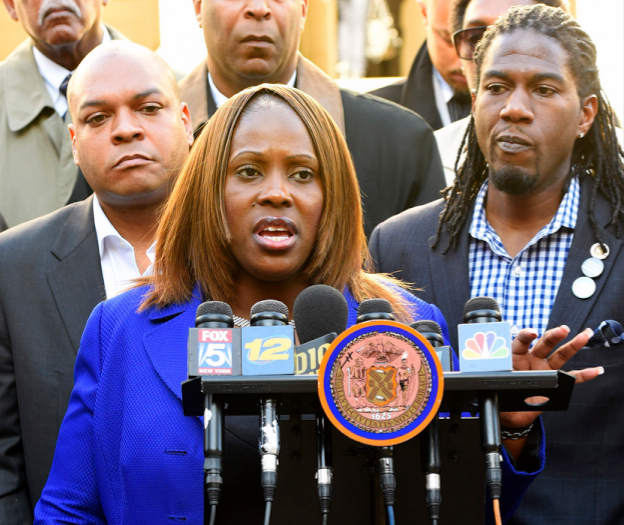
CMs Gibson, center, & Williams, right, are two of the co-authors (photo: William Alatriste)
NYPD Detective Brian Moore is one of the latest victims of a gun violence pandemic that has deeply wounded our city. This tragic event illuminates a stark reality: with this many guns on the street, senseless and random violence can happen in the blink of an eye. Despite improved efforts to take guns off the streets, engage youth in positive outlets, and interrupt the interstate gun pipeline (through which the gun used to kill Det. Moore came), gun violence continues to plague us.
Real Estate’s Attempt to Co-opt the Affordable Housing Discussion
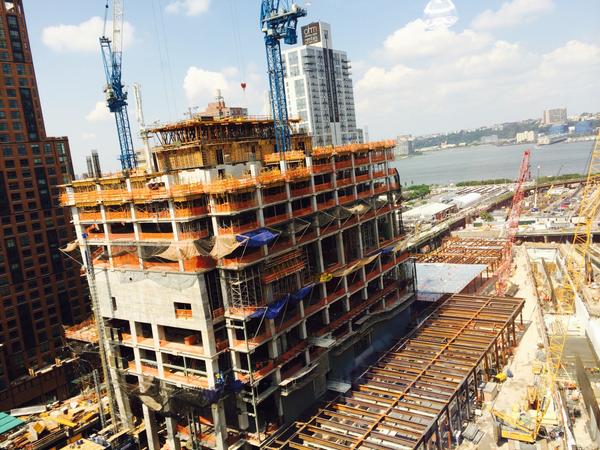
Construction at 10 Hudson Yards (photo: @ryanhutchins)
Think of the classic pieces of advice you’ve heard from parents, teachers or mentors along the way in life: Look before you leap. Think before you speak. Consider the source.
Sometimes we forget the obvious. This has been the case over the past two years, as an organization with a long track record of blocking all efforts to advance an affordable housing agenda has suddenly become a leading voice in the debate about how best to pursue this much-needed public policy goal.
Cleverly, the Real Estate Board of New York (REBNY) has seized on the de Blasio administration’s focus on affordable housing as the latest way to fight something they have opposed for five decades: the designation of city landmarks. Now REBNY declares that landmarking is bad for affordable housing. The contention is as baseless as it is self-serving.
Consider the source: REBNY’s mission is to maximize profits and eliminate regulatory hurdles for developers and property owners. It sees landmarks and historic districts as obstacles on that path, and historically has been no friend to affordable housing advocates. To further its mission, REBNY has been a longtime key funder of maintaining the Republican majority in the State Senate – which consistently opposes every affordable housing preservation initiative. Is this really a group that should have the ear of the city’s top housing policymakers on this subject?
A recent report issued by the Greenwich Village Society for Historic Preservation, “Check the Facts and Consider the Source: Campaign Cash and REBNY’s Real Record on Affordable Housing” reveals that although REBNY represents New York City owners and developers, the group furthers its policy agenda by investing heavily in elections upstate and on Long Island. In the month before last fall’s state elections, the group’s new “Jobs for New York” political action committee raised $2.5 million toward the goal of electing Republicans in Senate districts. The effort was successful: In the five races targeted - all outside of New York City - Republican candidates won, moving the Senate to complete GOP control.
A look back over the past 10 years further demonstrates a strong pattern:
-
Over the decade from October 2004 through October 2014, the Real Estate Board PAC was the #2 interest-group donor to the New York Republican State Committee, second only to the landlords’ Rent Stabilization Association PAC.
-
Over the decade from October 2004 through October 2014, the Real Estate Board PAC was consistently in the top ten largest interest-group donors to the NYS Senate Republican Campaign Committee, giving $454,000.
-
Over the decade from October 2004 through 2014, the Real Estate Board PAC gave more than four times as much to the Republican senate campaign committee as to the Democratic one.
-
From 2011 to 2013, despite being a New York City organization, nearly three-quarters of REBNY contributions went to candidates in districts outside the city.
-
When the contributions of REBNY officers are added to the mix – like those of Glenwood Management owner Leonard Litwin – the numbers become even more dramatic. From 2011 to 2013, the combined group gave 31 times as much to the Republican State Senate Committee as to the Democratic one.
In the words of veteran housing activist Michael McKee, “Real estate money has prevented action on any and all bills that would benefit tenants or stop the loss of affordable housing. Not a single pro-tenant bill has made it to the floor [of the state Senate] in the last four years.”
Yet city and state officials have been heard parroting REBNY’s self-serving “argument.” Why not learn, instead, from the people who work to build affordable housing day in and day out? We at GVSHP queried those professionals, and they found it laughable to connect landmarking to the challenges of building affordable housing. Rather, they said the top obstacles to such development include the rising costs of land and construction; scarce and declining subsidies; and an inability to reap the economies of scale that market-rate developers depend on.
Another reason to “consider the source” is REBNY’s record of crying wolf over the designation of historic districts that today’s New Yorkers consider essential. Just after the Landmarks Law was signed in 1965, a REBNY official was quoted in the New York Times warning that the new law would “seriously impede the modern expansion and progress of the city” – a prediction that clearly did not come true.
In 1986, REBNY opposed the designation of the Ladies’ Mile Historic District on lower Fifth Avenue, saying it would have “a chilling effect on the renovations and adaptations of long-vacant buildings” – clearly belied by today’s vibrant shopping district with robust rental rates. In 1988, REBNY opposed the creation of the Central Park West Historic District, explaining that it was opposing this one because it always opposes them. For decades, the group has been calling for our city’s landmarks law to be rolled back.
From the current investigation of Senate Majority Leader Dean Skelos to the recent indictment of Assembly Speaker Sheldon Speaker – who is accused, among other things, of using Litwin’s Glenwood Management to get kickbacks – the paths that real estate money takes in New York city and state government are often not pretty. And their attempts to influence the process extend far beyond the state Legislature; indeed, REBNY’s largesse has been lavished on both Governor Cuomo and Mayor de Blasio.
But that’s not a good reason to let the Real Estate Board become the authors of, or authorities on, public policy about affordable housing or landmarking. We wouldn’t want the NRA to write legislation about gun safety, nor the oil and gas industry to dictate policy on renewable energy sources. Check the record, and consider the source.
***
Karen Loew is Director of East Village and Special Projects at the Greenwich Village Society for Historic Preservation.
Community Leaders Do Work to Stop the Violence
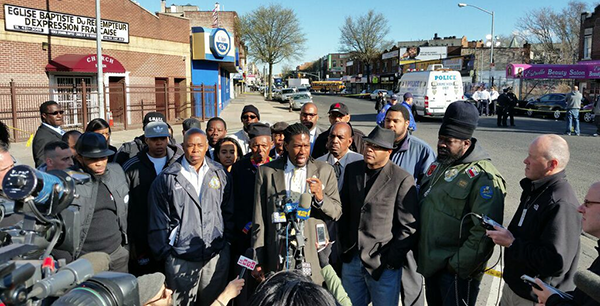
CM Jumaane Williams and others decry gun violence in Flatbush, BK (Alex Vitale)
In the wake of the protests following the Eric Garner and Michael Brown grand jury decisions the conservative echo chamber was abuzz with talk of “black on black crime.” Former Mayor Rudy Giuliani led the charge by calling people protesting police killings hypocritical for not speaking out as forcefully against blacks who are killing other blacks. That discourse has continued as protests and rioting take place in Baltimore. As Gary Younge pointed out in the Nation, this is a racial canard designed to deflect attention from the very real problem of police killings of unarmed black men.
In fact, black people are deeply concerned about these issues and working hard to try to combat the problem, with very little support from conservatives like Giuliani. As Younge said, “Anyone who seriously thinks that black people are not talking about black people killing other black people just doesn’t know any black people.”
Monday night 6 people were shot, 2 fatally, outside a church in Flatbush, Brooklyn. The exact causes are not known, but it may have involved an escalation of a long-standing conflict between specific individuals, with others caught in the crossfire.
This tragic loss of black lives immediately provoked a significant response from community leaders and institutions working to stop the violence. City Council Member Jumaane Williams has been a tireless advocate for additional funding for community-based anti-violence initiatives. As co-chair of the City Council’s Gun Violence Task Force he has orchestrated money for a variety of violence interruption programs across the city. Based on the Cure Violence model, these programs take a public health-centered approach to interrupting the cycle of retributory violence and work with high-risk youth to get them off the street and into positive activities. This is a stark alternative to the mostly punitive methods of violence control that predominate in poor communities of color. Rather than rely on police and prisons that typically respond after the damage is done, these programs attempt to prevent the violence from occurring in the first place by reaching kids at an interpersonal level.
Immediately following Monday night’s shootings, members of Gangstas Making Astronomical Community Changes (GMACC) went out on the streets to try to find out exactly what had happened in an effort to engage in rumor control. Too often acts of violence are misinterpreted, leading people to make false accusations that can lead to further violence. Once the facts are known, those close to the event can be reached on a peer-to-peer level to try to stop acts of retaliation.
Tuesday morning, local political and community leaders such as Borough President Eric Adams, Council Members Jumaane Williams and Mathieu Eugene, local religious leaders, and anti-violence activists such as Tony Herbert held a press conference in which they worked to ensure that accurate information was presented about the event in hopes of avoiding an escalation of tensions. In particular, they were concerned about press reports that the incident had been “gang related.” Each speaker pointed out that there was no evidence for this and that to call it such would potentially provoke the involvement of those in gangs in the area.
In addition, speakers like Shanduke McPhatter of GMACC emphasized the need to develop a change in the mindset of people in the community who keep turning to guns. While Council Member Williams pointed a finger at the role of the NRA in gun violence, McPhatter noted that people will pick up a knife if a gun isn’t as handy and their state of mind is oriented toward violence.
GMACC is now working closely with the community-based organization East Flatbush Village, which received money from the City Council a year ago to provide wrap around services for “at risk youth.” Their new program is providing young people with after-school mentoring, athletics, and counseling in hopes of diverting these young people from a life on the streets. In many cases these young people have experienced violence and abuse and have had nowhere to turn in the past. As John Jay College criminologist David Kennedy points out in his review of Jill Leovy’s book Ghettocide, the police and criminal justice systems are not oriented toward helping the victims of inner-city violence, who then often go on to become perpetrators. The cycles of arrest and incarceration often serve to further traumatize these young people rather than healing them in a way that breaks the cycle of violence.
East Flatbush Village is working with several local schools in the 76th Precinct to identify young people in need and involve them in organized athletics, with coaches who also act as mentors and positive adult role models - something often lacking for these young people. They also participate in regular peer-to-peer and individualized counseling. They are asked to “check in” about what’s going on in their lives in hopes of identifying and interrupting violent and self-destructive patterns of behavior.
These community-based initiatives are not a panacea, they have to be part of larger structural changes that provide people with real avenues out of poverty and social isolation. To that end, Williams and the City Council are also calling for a huge increase in summer jobs for young people in low income communities across the city in this year’s budget. There is abundant evidence that large scale jobs programs can help reduce crime and set young people on a more positive course. In addition, they lack all the negative collateral effects that stem from relying on a criminal justice based approach.
Cure violence programs received additional support from Mayor de Blasio in last year’s budget, marking a break from Mayor Bloomberg, who consistently blocked such funding. It is ironic that those who shift the blame for police violence and mistreatment onto communities of color provide so little support to those working to improve these communities. While mayor, Giuliani consistently reduced support for community-based programs designed to engage young people in the arts, sports and employment. To then accuse those communities of not caring about crime and violence is the height of politically-motivated hypocrisy.
***
Alex S. Vitale is associate professor of sociology at Brooklyn College and author of City of Disorder: How the Quality of Life Campaign Transformed New York Politics. He is senior policy adviser to the Police Reform Organizing Project and serves on the New York State Advisory Committee to the US Civil Rights Commission. You can follow him on Twitter: @avitale
***
Have an op-ed idea or submission for Gotham Gazette? E-mail editor Ben Max: This email address is being protected from spambots. You need JavaScript enabled to view it.
Fix Water Mains, Improve Transit
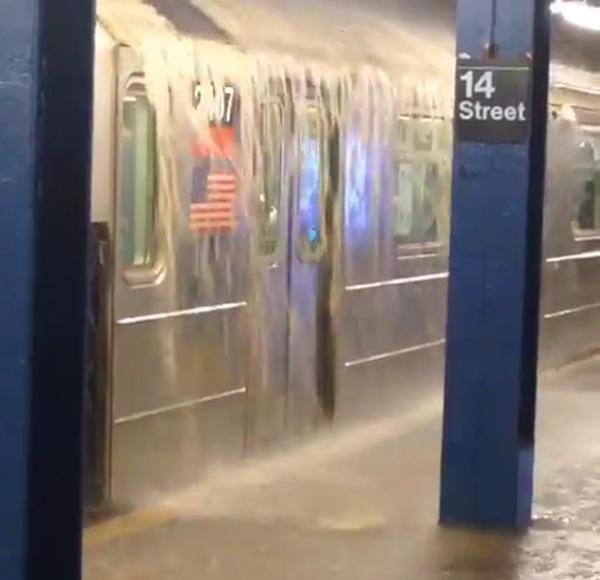
Water floods the subway (photo: @NYCityAlerts)
Mayor Bill de Blasio's executive budget is expected soon and one of the issues attracting attention is the size of the city's contribution to the MTA. While the mayor rightly urges Albany to come up with sustainable, long-term capital support for the regional transit network, the city's contribution to the MTA Capital Plan is today less than half of its peak in 1989, during the Koch Administration. Certainly, there should be a way for the mayor to find significantly more city money to support the bus and subway system that is the lifeblood of our city. But there's another way the mayor can support the MTA: increase funding to keep damaging water out of the subway.
Just in the past month, we had an illustration of how one system of crumbling infrastructure can contribute to the problems of another. When a water main broke in the West Village on April 7, water came cascading into the 14th Street Station on the 7th Avenue line, interrupting 1, 2, and 3 train service. The dramatic video of water showering a train in the station attracted a lot of attention on social media and elsewhere. But this incident is just one of several since Mayor de Blasio took office that highlight the importance of the city repairing its ancient water system. Others:
January 15, 2014 – a 137-year-old water main break near Union Square requires the diversion of multiple train lines during the morning rush hour
November 22, 2014 – a water main break in the Bronx floods the E 145th Station and requires suspension of 6 train service
April 1, 2015 – a water main break near Central Park West and 96th Street causes disruption in B and C train service
In each one of these incidents, the MTA mobilized people and equipment to restore service and make repairs as needed to subway equipment and infrastructure. While it may be difficult for the MTA to break down the costs for each incident like this, it's clear that expenditures for labor and materials are not insubstantial. In addition, there are costs to the MTA in lost ridership revenue when these events take place. When you factor in additional economic costs of delaying commutes for thousands of people and lost business income, the total economic costs of this problem mount up.
A review of the mayor's preliminary budget for fiscal year 2016 shows capital expenditures of $325 million over 10 years to replace aging underground water mains. That's just $32.5 million per year. For emergency repairs to broken water mains, there's an additional $116 million over that same period – less than $12 million per year. These numbers are woefully inadequate. According to a March 2014 report by the Center for an Urban Future, the city's water main replacement program has been replacing only about one-third of what's required to approach a state of good repair. The result: more than 400 water main breaks in New York City last year and every year since 1998 but one.
The risk of underinvestment in our water infrastructure is becoming more apparent each time a water main break disrupts our transit network. If the mayor wants to keep the heat on Albany to fund the MTA, so be it. But he can also help support better transit by pumping more resources into repairing the city's aging water infrastructure.
***
Peter Peyser is a public affairs consultant living in New York. He served in the Koch Administration in the mayor's Washington, DC office.
***
Have an op-ed idea or submission for Gotham Gazette? E-mail editor Ben Max: This email address is being protected from spambots. You need JavaScript enabled to view it.
Better Understanding Entry to the City's Specialized High Schools
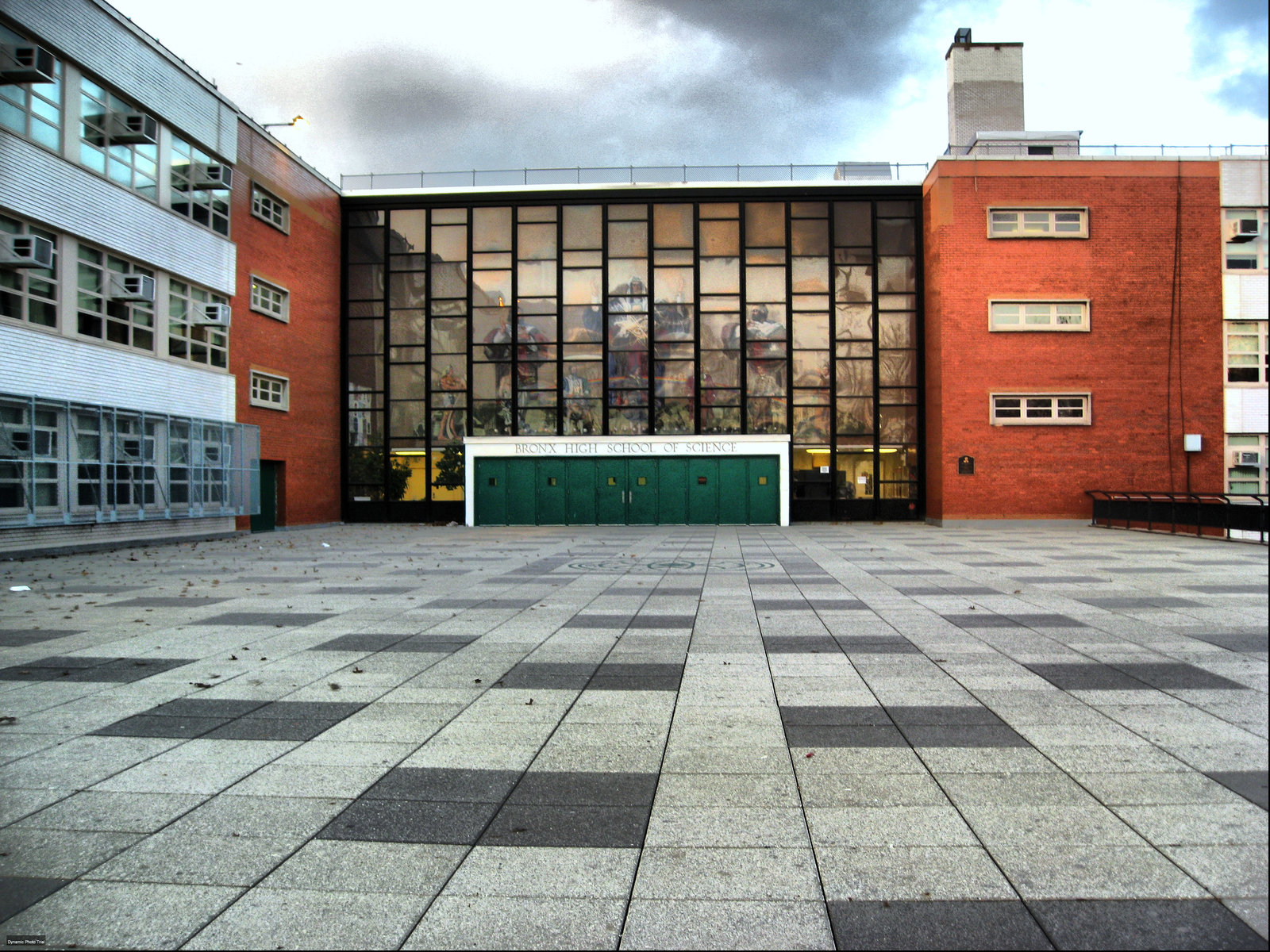
Bronx High School of Science
A recent report by the city's Independent Budget Office claimed that the city's eight test-in specialized high schools – including my alma mater Brooklyn Tech, where I head the alumni foundation – have higher percentages of students from higher-income census tracts than the average in all city high schools. Some politicians, activists and academics who are hostile to the use of a pure merit system for selecting students for these schools have attempted to argue that this report somehow shows that the test-in schools are for the wealthy among us. That is misleading to say the least.
The facts are that the specialized high schools are the most economically diverse of all high-performing public high schools in the city.
The IBO report did not point out that in the academic year ending last June, 52.4 percent of students in the eight specialized high schools (including two-thirds at Brooklyn Tech) qualified for free or reduced-cost lunch, the federally-established measure of poverty used by the school system. By comparison, just 37.6 percent of students at the eight highest-performing selective high schools (based on SAT scores) that use the more subjective multiple criteria wanted by critics of the test qualified for the lunch program.
It should come as no surprise that specialized high schools, which draw students from across the city, would have more students from higher-income brackets than neighborhood-based schools where the student bodies reflect the socioeconomic standing in those communities. The IBO report reflects that higher-income neighborhoods have better performing schools because they are given better resources. But an apples-to-apples comparison shows that the specialized high schools continue to draw far more economically-diverse student bodies than schools using subjective criteria to decide admissions. In other words, use of the test, the SHSAT, prevents parents of less academically-prepared children from wealthy families from using non-pedagogical influence to gain admittance.
New York's test-in high schools like Brooklyn Tech, Stuyvesant and Bronx Science provide an incredibly challenging college-level curriculum to the children of New York City's working class, immigrant and poor families. For 90 years their students have received an unmatched public school education enabling them to go to the nation's best colleges and have a real opportunity to escape the poverty they were born into.
In many instances these graduates have gone on to do great things benefiting our society. Diseases have been cured, wars won, and marvelous inventions have been created which improved the lives of millions. Fourteen graduates have received the Nobel Prize, more than most nations can claim.
The State Senate Education Committee will vote Tuesday on a bill to end the reliance on the Specialized High School Admissions Test without having heard five minutes of testimony from either side of the issue. Senators could have listened to representatives from the NYU Research Alliance for New York City Schools, which recently released a report showing many of the proposed changes – such as using state assessment test scores, grades and attendance – either would result in little change in specialized school admission rates for underrepresented minorities or could actually result in fewer black and more white students being offered admission.
There are over 1,900 African-American and Latino students currently attending the specialized high schools. There should be more. What is missing from the bill and from the IBO report is a true understanding of what must be done to improve the racial and ethnic diversity of students attending these schools.
Instead of eliminating the test-in system which guarantees all applicants a fair and objective standard for admission, the city should work far harder to give students from underrepresented communities the same educational opportunities in elementary and middle school grades currently being afforded students in higher-income neighborhoods. It is discouraging to see recent reports that the city is not offering Gifted and Talented Programs in so many communities that are later underrepresented in the specialized high schools.
Similarly, too few students from underrepresented communities sign up to take the SHSAT, perpetuating a cycle of disenfranchisement that requires a commitment and investment of resources to change. The school system should identify high-performing students, nurture them through enhanced academic programming and test preparation to ready them for the rigors of the exam and the schools' curriculum.
It can be done. The Brooklyn Tech Alumni Foundation, working with the school and a grant from National Grid (which is led by a Tech graduate), just saw the fruits of a pilot "pipeline" program it established to focus on students from underrepresented middle schools across Brooklyn. Of 30 students who went through the program – which included tutoring, enhanced academics and test preparation – 26 received an offer of admission to either Brooklyn Tech or Stuyvesant. Half of the students offered admission to Tech were African-American or Latino. More importantly, because of an even broader effort by the school to reach out to underrepresented middle schools, over 300 African-American and Latino students were offered admission this year to Brooklyn Tech, reversing a downward trend of many years.
I am a labor lawyer and have spent my entire 30-year career fighting for the rights of poor and working people. I believe in diversity, fairness, merit and providing excellent educational opportunities for the children of working families. If we are to reduce the huge income inequality in our city we must reduce the huge educational inequality of our elementary and middle schools. And, we must preserve the specialized high schools which truly have been – and remain – the engines of social advancement for the children of New York's poor, immigrant and working class families.
***
Larry Cary is the President of the Brooklyn Tech Alumni Foundation.
***
Have an op-ed idea or submission for Gotham Gazette? E-mail editor Ben Max: This email address is being protected from spambots. You need JavaScript enabled to view it.




